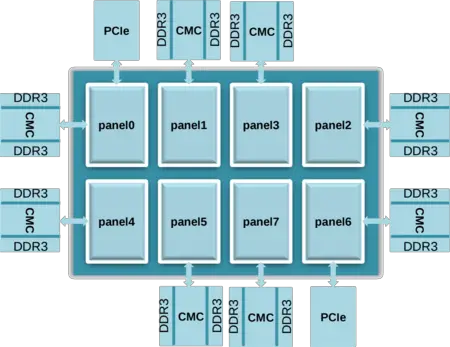(→Panel Architecture) |
|||
| Line 87: | Line 87: | ||
=== Panel Architecture === | === Panel Architecture === | ||
| − | + | [[File:xiaomi panel-based data affinity architecture.png|right|450px]] | |
| + | Phytium organizes their processors using a grid-layout they call '''Panels''' they call '''Panel-based data affinity architecture'''. Each panel consists of 8 independent [[ARMv8]]-compatible cores. Phytium "Mars" processor consists of 8 such panels for a total of [[64 cores]]. Panels are interconnected with a 2-dimensional mesh network-on-a-chip [[level 2 cache]] with 4 MiB per panel for a total of 32 MiB. | ||
| + | |||
| + | In addition to the main die, Mars uses an additional '''Cache & Memory chips''' ('''CMC''') auxiliary chips. "Mars" uses 8 such chips connected to the main die providing 16 MiB of [[level 3 cache]] for a total of 128 MiB as well as 8 dual-channel DDR3-1600 [[memory controller]]s for a total maximum bandwidth of 204 GB/s. Mars also provides two 16-lane PCIe 3.0 interfaces. The chips incorporates ECC and parity protection on all caches, tags, and TLBs. | ||
=== Block Diagram === | === Block Diagram === | ||
Revision as of 23:47, 9 February 2017
| Edit Values | |
| Xiaomi µarch | |
| General Info | |
| Arch Type | CPU |
| Designer | Phytium |
| Manufacturer | TSMC |
| Introduction | 2017 |
| Process | 28 nm |
| Pipeline | |
| Type | Superscalar |
| Speculative | Yes |
| Reg Renaming | Yes |
| Instructions | |
| ISA | ARMv8 |
| Cores | |
| Core Names | FTC660, FTC661 |
Xiaomi is an ARM microarchitecture designed in-house by Phytium for their consumer market and server-based microprocessors.
Contents
Brands
| Codename | Brand | Description |
|---|---|---|
| Mars | FT-2000 |
|
| Earth | FT-1500A |
|
Architecture
Overview
- Fully ARMv8 compatible
- Support AArch32 and AArch64 modes
- EL0-EL3 supported
- ASIMD-128
- 28 nm process
- Scalable design
- 4 to 64 cores
- Mesh topology network-on-chip
- Panel-based (grid) architecture
- Global cache coherency
- 2x DDR3-1600 channels per panel
- ECC support
- 2x 16-lane PCIe 3.0
Panel Architecture
Phytium organizes their processors using a grid-layout they call Panels they call Panel-based data affinity architecture. Each panel consists of 8 independent ARMv8-compatible cores. Phytium "Mars" processor consists of 8 such panels for a total of 64 cores. Panels are interconnected with a 2-dimensional mesh network-on-a-chip level 2 cache with 4 MiB per panel for a total of 32 MiB.
In addition to the main die, Mars uses an additional Cache & Memory chips (CMC) auxiliary chips. "Mars" uses 8 such chips connected to the main die providing 16 MiB of level 3 cache for a total of 128 MiB as well as 8 dual-channel DDR3-1600 memory controllers for a total maximum bandwidth of 204 GB/s. Mars also provides two 16-lane PCIe 3.0 interfaces. The chips incorporates ECC and parity protection on all caches, tags, and TLBs.
Block Diagram
| This section is empty; you can help add the missing info by editing this page. |
Memory Hierarchy
| This section is empty; you can help add the missing info by editing this page. |
Pipeline
| This section is empty; you can help add the missing info by editing this page. |
References
- Zhang, C. (2015, August). Mars: A 64-core ARMv8 processor. In Hot Chips 27 Symposium (HCS), 2015 IEEE (pp. 1-23). IEEE.
| codename | Xiaomi + |
| designer | Phytium + |
| first launched | 2017 + |
| full page name | phytium/microarchitectures/xiaomi + |
| instance of | microarchitecture + |
| instruction set architecture | ARMv8 + |
| manufacturer | TSMC + |
| microarchitecture type | CPU + |
| name | Xiaomi + |
| process | 28 nm (0.028 μm, 2.8e-5 mm) + |
